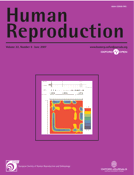-
PDF
- Split View
-
Views
-
Cite
Cite
Mohamed A. Bedaiwy, Tommaso Falcone, Reply: Cryopreservation of intact human ovary with its vascular pedicle—or cryopreservation of hemi ovaries, Human Reproduction, Volume 22, Issue 6, June 2007, Pages 1796–1797, https://doi.org/10.1093/humrep/dem048
Close - Share Icon Share
Sir,
We would like to thank Professor Donnez and associates for their interest in our manuscript entitled ‘Cryopreservation of intact human ovary with its vascular pedicle’. Regarding the questions they raised with respect to our work, our responses are as follows.
First, we need to re-emphasize that this work is purely experimental and the result of the observation that ischemia is responsible for most of the graft failures. This work is simply an evolution of our sheep data published previously. We first described the technique of cryopreserving a whole ovary with its vascular pedicle in the sheep animal model, and we demonstrated the potential feasibility as evidenced by vascular patency and hormonal function (Jeremias et al., 2002; Bedaiwy et al., 2003). More recently, Imhof et al. (2006) described pregnancy and delivery using an orthotopic approach of whole ovary vascular anastomosis (Imhof et al., 2006). Our present paper was intended to take it to the next experimental level with human ovaries (Bedaiwy et al., 2006). We did not intend to proceed to transplantation but simply to see if we can carry out the steps we reported.
As noted in our manuscript, the main and the most critical step in the entire process—the perfusion of the cryoprotectant—was performed via the ovarian vessels to ensure adequate distribution of the cryoprotectant via the intraovarian vascular network. Bisecting the ovary to fit in the largest available cryovial thereafter would not change the fact that the perfusion process was performed on an intact ovary and the entire ovary cryopreserved. Should a cryovial with an adequate size be available, the rest of the process could have been performed with the ovary intact as we did in our initial experiment in sheep ovaries (Bedaiwy et al., 2003). A specially designed cryovial and cryochamber to accommodate an entire ovary with its vascular pedicle is being developed by industry.
Second, both ovaries fit after bisection in the cryovial described in our study. We agree with their concern regarding the fact that fitting ovaries with larger sizes in this particular cryovial is challenging. In this limited series, we purposely chose older women whom we knew would have small ovaries. The data they quoted in their letter state that there is a progressive decline in ovarian volume from 10 ml in women less than 30 years of age to 6.8 ml in women from 36 to 40 years of age. Our two patients were 44 and 46 years of age and easily fit into the 5 ml cryovial. We agree that in clinical practice when we are dealing with young women we can never use the present cryovials. We simply chose ovaries that we knew were at the end of their reproductive life with small ovaries. As for the preparation of the ovarian cortical strips, we used the protocol described by Gosden and associates (Gosden et al., 1994).
Third, we used fetal calf serum for experimentation purposes only. Indeed animal free media would be the only way to proceed if autotransplantation is planned. This study was again just an experiment to assess feasibility.
Fourth, this paper was presented, in part, as an abstract in the ESHRE meeting of 2004. Only one patient from that abstract published in 2004 was included in this report and the other patient and all the controls in the current manuscript were from subsequent work. The patient in common between the abstract and the current manuscript is the 44 years old patient who underwent laparoscopic hysterectomy and bilateral salpingo-ophrectomy. The other patient from the 2004 ESHRE abstract, who underwent cryopreservation of both ovaries as ovarian cortical strips, was not included in the current manuscript because; (i) both ovaries were cryopreserved as ovarian cortical strips and we did not do a whole ovary freezing on her and (ii) we did not run some of the in vitro assessment strategies, namely, the CD 34, PAS and Masson's trichome stains on the tissues obtained from this patient.
Fifth, as demonstrated in the elaborate in vitro experiments we did, adequate and comparable tissue survival was achieved in both study arms using the described protocol of thawing. Cannulation of the largest branch of the ovarian vessels in the section that did have the pedicle connected was performed to wash out the cryoprotectants. We also would like to emphasize that we did not use sucrose and PBS as a thawing medium in this study and it was quoted in the 2004 ESHRE abstract by mistake. We used only leibovitz L-15 medium supplemented with 10% FCS to wash out the cryoprotectant following the protocol we used earlier (Bedaiwy et al., 2003).
Sixth, regarding our statement that ovarian tissue could tolerate adequately varying concentrations of DMSO with comparable post-thaw survival, we agree that the difference in concentration was not large, we used 1.5 M DMSO and they used 1.4 M DMSO (Martinez-Madrid et al., 2004).
In conclusion, we understand the controversy in this area as cryopreservation of an intact organ is really challenging and still in its infancy. We wish to again point out that this work was only an extension of our whole organ work in sheep and in no way was intended for clinical use. We congratulate this group for successfully carrying out cryopreservation of a whole ovary with a vascular pedicle using the vascular pedicle for perfusion of cryoprotectant in nine patients. We look forward to seeing the results published and look forward to their first successful transplant.



